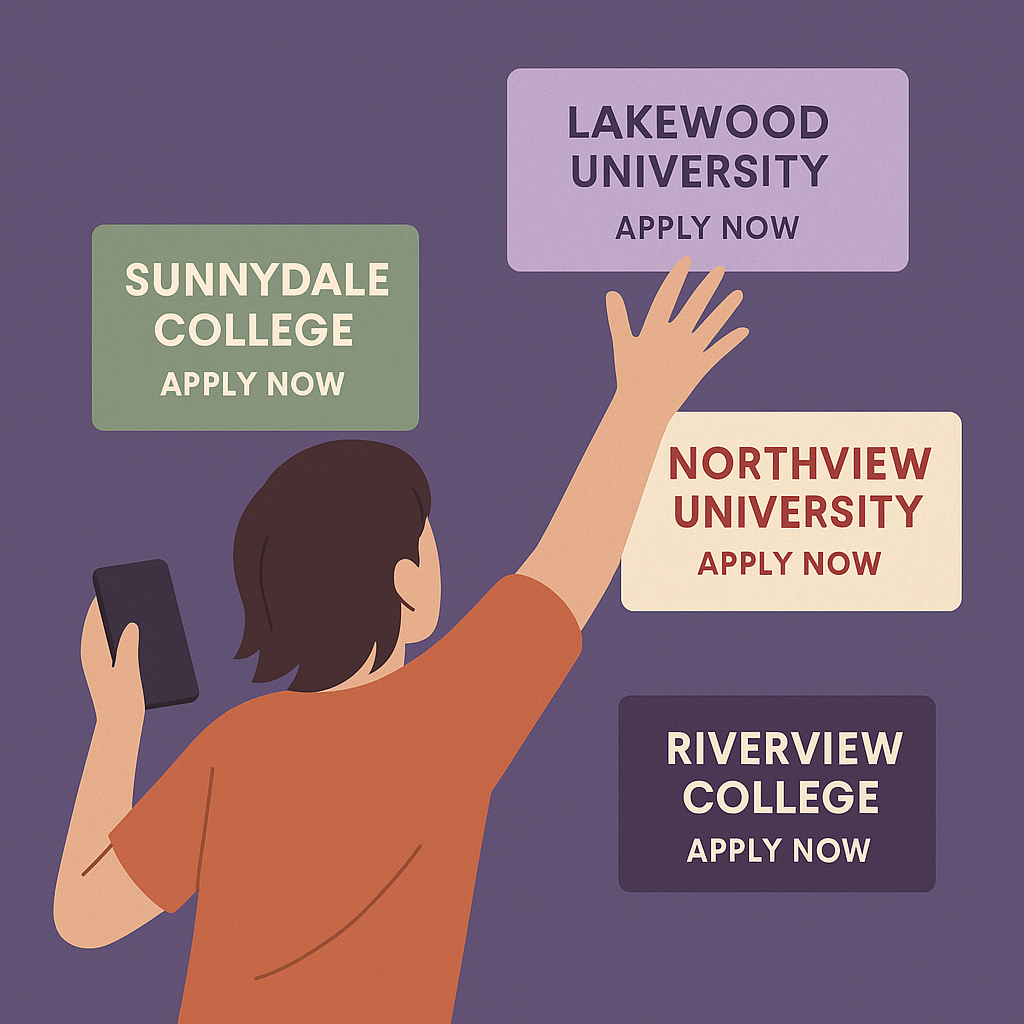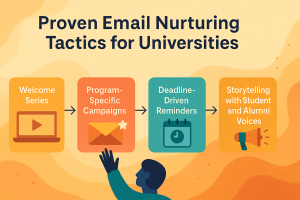Thousands of students showed interest. Only a fraction applied. What happened in between? That space—between inquiry and enrollment—is where most universities lose momentum. It’s not a lack of awareness that holds students back; it’s hesitation, unanswered questions, forgotten deadlines, and lack of personal connection. While generating inquiries is essential, the real lever for growth lies in what comes after: nurturing.
Students today are making complex, emotional, and high-stakes decisions. They’re comparison shopping, exploring options, and waiting to feel seen. To move them from curiosity to commitment, institutions need structured, multi-channel lead nurturing strategies that guide, inform, and inspire. This guide explores how to do exactly that—with proven email, SMS, and marketing automation tactics tailored to the higher education journey.
Why Lead Nurturing is Critical for Higher Education
1. Students Have Long and Non-Linear Decision Cycles
Unlike traditional sales funnels, prospective students in higher education take their time. Many students start exploring schools 12–24 months before applying. Their journey often includes multiple visits to your website, interactions with different departments, and even contact with competing institutions. This prolonged decision-making process makes it critical to remain present and relevant throughout.
2. Application Abandonment is Common
It’s not uncommon for students to begin applications and then abandon them midway. Reasons vary—lack of time, unanswered questions, or feeling overwhelmed. Timely and supportive follow-ups can re-engage these leads and help push them to completion.
3. Effective Nurturing Increases Yield
Consistent and relevant communication helps build emotional connections. When students feel seen and supported, they’re more likely to move forward. Nurturing helps position your institution not just as an option, but as the right choice.
Building a Lead Nurturing Framework for Higher Education
1. Segment Your Audiences
Personalization starts with segmentation. Use your CRM and inquiry forms to group leads by attributes such as:
-
Program of Interest: Business, Nursing, Engineering, Liberal Arts
-
Student Type: Undergraduate, Graduate, Transfer, Adult Learner
-
Geographic Region: In-state, out-of-state, international
-
Inquiry Source: College fairs, Google Ads, social media, referrals
Each group has unique needs and motivations, and tailoring your messaging accordingly improves engagement.
2. Design Multi-Channel Nurture Journeys
A single channel won’t cut it. Combine multiple communication methods for the best results:
| Channel | Best Use Case |
|---|---|
| Deep dives into programs, campus culture, storytelling | |
| SMS | Quick deadline reminders, event updates, confirmations |
| Automation | Delivering triggered messages based on student behavior or funnel stage |
A student who downloads a financial aid brochure should receive content that supports that interest. Similarly, an applicant nearing a deadline should receive timely nudges via SMS and email to complete their application.
3. Map Communications to Funnel Stages
Align your messaging with where the student is in the enrollment funnel:
| Funnel Stage | Messaging Focus |
|---|---|
| Inquiry | Welcome series, introduction to campus life, contact info |
| Consideration | Program benefits, testimonials, financial aid options |
| Application | Application checklist, deadlines, faculty videos |
| Decision | Admitted student next steps, housing info, yield events |
This approach ensures students receive the right message at the right time.
Proven Email Nurturing Tactics for Universities
1. Welcome Series
The first 24 hours after an inquiry are crucial. Send a welcome email that thanks the student, outlines what they can expect, and introduces the university’s brand and values. Include:
-
A personal note from admissions
-
A video campus tour
-
Links to explore programs, housing, and student life
2. Program-Specific Campaigns
Don’t send generic emails to everyone. Use the student’s stated interest to guide content. For instance, a business student may receive:
-
Alumni career stories in business
-
Internship success rates
-
Faculty research highlights
3. Deadline-Driven Reminders
Urgency works. Send countdown emails in the final weeks before major deadlines, and include:
-
Scholarship cutoff dates
-
Housing deposit deadlines
-
Early decision options
Include clear CTAs and links to the application portal.
4. Storytelling with Student and Alumni Voices
Peer influence is powerful. Feature stories of current students, alumni achievements, and first-generation successes. Multimedia content like video testimonials, blogs, or Instagram takeovers make these stories even more impactful.
5. A/B Test Subject Lines and Content
Continuously test your messages to optimize performance. Try variations of:
-
Subject lines with emojis vs. plain text
-
Emails with images vs. text-heavy layouts
-
Long-form vs. bite-sized copy
Track open rates, click-throughs, and conversions. In higher ed, aim for:
-
Open Rates: 20–30%
-
Click-Through Rates (CTR): 3–5%
SMS Lead Nurturing Strategies for Higher Education
Why SMS Works
SMS is one of the most effective communication tools, especially in higher education. With an impressive 98% open rate—far higher than email—it’s ideal for time-sensitive, action-oriented messages. Students are almost always on their phones, making SMS a direct and reliable way to connect with prospective applicants. For colleges and universities aiming to boost engagement, SMS can bridge the gap between initial interest and enrollment in higher education programs.
Best Practices for SMS Nurturing
To make the most of SMS in your higher education recruitment strategy, follow these best practices:
- Keep It Short and Clear: Students prefer quick, digestible messages. Avoid long, complex texts.
- Personalize Messages: Always include the student’s first name and reference their program of interest to make it feel tailored.
- Include a Strong Call-to-Action (CTA): Encourage students to take the next step—like completing an application, RSVPing to an event, or scheduling a campus tour.
- Secure Consent and Provide Opt-Out Options: Always adhere to compliance standards by ensuring students opt in to receive texts. Make it easy for them to unsubscribe if needed.
Sample SMS Scripts
Here are a few examples of how you can nurture higher education leads with SMS:
- “Hi [First Name], don’t miss out! Our Fall 2025 application deadline is THIS Friday. Complete your app today: [Link].”
- “Hey [First Name], we’re thrilled to see you at our Open House this weekend! Need help with directions? Click here: [Link].”
- “You’re almost there! Complete your Nursing application today to meet the priority deadline: [Link].”
- “Hi [First Name], did you know there’s still time to qualify for priority scholarships? Submit your application before next week’s deadline: [Link].”
Why SMS Should Be a Part of Your Higher Education Strategy
SMS is not a one-size-fits-all solution but an incredibly effective complement to your broader communication strategy. Use it alongside email, social media, and in-person outreach to create a seamless experience for prospective students. While email can provide detailed information, SMS is perfect for delivering quick reminders and urgent updates that drive immediate action. For institutions navigating the competitive higher education landscape, SMS is a powerful way to stand out, stay relevant, and nurture leads through every step of the enrollment process.
Marketing Automation Tactics That Drive Results
1. Behavioral Triggers
When students take certain actions (or don’t), automation should respond. For example:
-
A student views the financial aid page → send a scholarship overview email.
-
A student starts but doesn’t finish an application → trigger a 3-part reminder series.
2. Lead Scoring Models
Assign scores based on:
-
Email opens and click rates
-
Time spent on the website
-
Event attendance
-
Application progress
Then prioritize outreach to leads with the highest scores.
3. Personalized Dynamic Content
Use data to auto-insert relevant content into emails:
-
“Hi Sarah, are you still considering our Engineering program?”
-
“Our next tour in New York is happening this Saturday—don’t miss out!”
Dynamic fields can increase engagement significantly.Propellant Media
4. Drip Campaigns
Set up a series of emails and texts over a defined period. For instance:
-
Week 1: Welcome email
-
Week 2: Program video
-
Week 3: Financial aid webinar invite
-
Week 4: Application checklist
Adapt the pace and content based on opens and clicks.
Real-World Lead Nurturing Example
Challenge: A regional university faced a 40% drop-off in application completions.
Strategy:
-
Developed segmented nurture tracks.
-
Launched welcome series, weekly deadline reminders, and personalized video tours.
-
Integrated with Slate CRM to automate triggers based on page visits and form completions.
Results:
-
28% increase in application completions
-
19% improvement in enrollment yield
-
Enhanced engagement across email and SMS
This transformation underscores the power of an intentional, data-driven nurturing strategy.
Measuring Lead Nurturing Success
| Metric | Why It Matters |
|---|---|
| Open Rate (Email) | Indicates subject line strength and list health |
| Click-Through Rate | Shows if your message resonates and drives action |
| Application Start Rate | Reflects pipeline growth |
| Completion Rate | Demonstrates funnel effectiveness |
| Cost Per Application | Connects nurturing performance to marketing ROI |
Use analytics tools within your CRM or marketing platform to track these over time and adjust strategies as needed.
Avoiding Common Lead Nurturing Mistakes
1. One-Size-Fits-All Messaging
Mistake: Sending the same email to every student
Solution: Segment audiences and tailor communications accordingly.
2. Overloading Students with Messages
Mistake: Bombarding inboxes and phones
Solution: Stick to a nurturing cadence that informs—not annoys.
3. Neglecting Mobile Optimization
Mistake: Sending emails that don’t display well on phones
Solution: Use responsive templates and test on multiple devices.
4. Failing to Align with Admissions Deadlines
Mistake: Missing critical timing windows
Solution: Integrate calendars into your automation workflows.
Future of Lead Nurturing in Higher Ed
1. AI-Driven Personalization
Artificial intelligence is transforming how institutions connect with prospective students. Platforms now use machine learning to analyze behavior patterns, such as website visits, email opens, and engagement times, to suggest optimal send times and messaging sequences. This ensures that communication feels timely and tailored, increasing the likelihood of student engagement and fostering a more personal connection.
2. Interactive Content
Engagement is key, and interactive content is leading the way in capturing student interest. Tools like quizzes that align students with suitable majors, immersive video campus tours that bring the college experience to life, and gamified application checklists that make the enrollment process feel more approachable are just some examples. These types of content not only hold attention but also encourage students to take the next steps in their journey.
3. Conversational Marketing
As students seek immediate answers, conversational marketing has become essential. AI chatbots, paired with live agents, offer real-time support on your website or via social platforms. They can answer frequently asked questions, assist in scheduling campus tours, and even guide prospective students through every stage of the application process. This 24/7 accessibility ensures no lead goes unanswered and helps build trust with prospective students.
4. CRM and Dashboard Integration
The integration of advanced CRM systems and real-time dashboards provides a major boost to efficiency for marketing and admissions teams. These tools allow teams to measure trends, track student interactions, and adjust strategies quickly based on insights. By creating a unified view of each prospective student, collaboration between departments improves, ensuring efforts are seamless and aligned to drive better results.
Conclusion: Lead Nurturing is the Bridge to Enrollment
No nurture, no numbers. Lead nurturing is what gets students from ‘maybe’ to ‘I’m in.’ Without an effective lead nurturing strategy in place, institutions risk losing prospective students to competitors who are better prepared to guide and engage them throughout the decision-making process. Prospective students today expect timely, personalized communication that addresses their unique needs and concerns. Failing to meet these expectations can mean losing out on valuable opportunities to connect.
By integrating email, SMS, and automation into a thoughtful, multi-channel approach, universities can:
- Build deeper and more authentic relationships with prospects by delivering personalized content at the right time.
- Encourage application completions by addressing common barriers or questions that often delay the process.
- Increase enrollment yield by nurturing trust and showcasing the value of their programs.
Key Takeaway: In an increasingly competitive higher education market, a well-executed lead nurturing strategy isn’t optional—it’s essential. It can mean the difference between missed opportunities and full classrooms, helping institutions stay ahead while creating a seamless, supportive experience for prospective students.
Don’t let qualified leads slip away. Propellant Media helps universities automate and personalize communication across email, SMS, and digital ads—keeping your school top-of-mind throughout the decision journey. Want to see what smarter nurturing looks like? Claim your free 30-minute demo today and let us walk you through real solutions driving 20–40% lifts in application rates.



